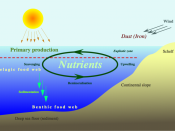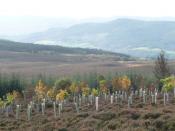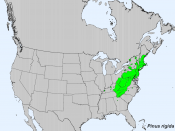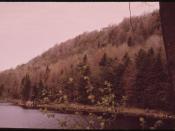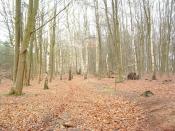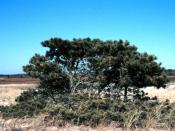Introduction: The purpose of this experiment was to find a difference, if any, between the tree species population and the relativity to a hill slope. The theory is that the nutrients leech from the top of a hill to the bottom so the trees that need more nutrients would be growing at the bottom of the hill and those that need less would be at the top. At the top of the hill it was expected that coniferous trees would be present including the white pine and the pitch pine. These species have traits that are adapted to require fewer nutrients such as: the nitrogen being held in the buds and the concept of the tree retaining the needle over winter. At the bottom the expected result would be that there would be some hardwood such as American basswood and Red maple in greater quantities than at the top of the hill.
These hardwood trees have leaves that fall off in the fall and are less adapted for harsh environments There should be a gradual change from the white pine and pitch pine at the top to more of a hardwood environment at the bottom. The results that were found were strikingly similar to the expected results. The results were that the top was primarily coniferous trees and gradually changed to hardwood down the hill.
Methods and Materials: In the forest, a 10 meter by 10 meter area was selected by picking a point going straight West 10 meters then turning 90 degrees and going 10 meters, repeating until a perfect square was formed using a compass as the guide and a measuring tape to measure the correct distance. The diameter of each tree was taken using a special tape measure that was a designed to get the diameter from the area around the tree. These samples were taken at different points up and down the slope of the hill. The results were brought back to the lab for analysis.
Results: The number of pitch pine and white pine are the dominant species at the top of the hill. (Table 1.) This can be compared to the graph of the top to bottom gradient that is very evident in Figure 1. The numbers of hardwood at the bottom of the hill are greatly increased from the top compared to the bottom. (Table 1.) This is illustrated in Figure 1. There is a gradual gradient that occurs from the top of the slope to the bottom of the slope. (Figure 1) The common names of the tree species are in Table 2.
Table 1. Absolute Important Values for tree species on various elevations.
PINSTR PINRIG BETPAP ACERUB QUEALB OSTVIR THUOCC ULMAME FRAAME PINRES TOP 95.4 104.575 0 0 0 0 0 0 0 0 MID 116.58 33.08 40 3.72 6.62 0 0 0 0 0 LOW 93.325 18.525 10.75 22.55 4.3 7.425 7.975 18.275 16.85 0 BOT 81.48 59.4 0 0 0 0 20.96 12.78 20.46 4.92 Table 2. Tree species common names and abbreviations Common Name Abbreviation American elm ULMAME Hophornbeam OSTVIR Northern White Cedar THUOCC Pitch Pine PINRIG Red Maple ACERUB Red Pine PINRES White Ash FRAAME White Birch BETPAP White Oak QUEALB White Pine PINSTR Figure 1. Tree specie populations as a gradient from top to bottom.
Discussion: The results were what was expected. The hardwood trees did not grow at the top of the hill because of the lack of nutrients at the top. The top of the hill was mostly sand which makes matters worse because sand cannot hold nutrients very well as it is. The hardwood was located at the bottom of the hill where it was nutrient-rich. The nutrient-deficient ground at the top was a prime spot for the white pine and pitch pine. The gradient was the gradual availability of nutrients going down the hill. Any source of error in this experiment was from estimation. Any results that are not actually counted out were prone to error because estimation's identity is that of making an educated guess of what the actual results would be.
Conclusion: At the top of the hill, there was little nutrients so there was no hardwood. At the bottom there was lots of nutrients so there was more hardwood. Coniferous trees have adapted to compensate for this deficiency in nutrients so they can grow at the top of the hill.
